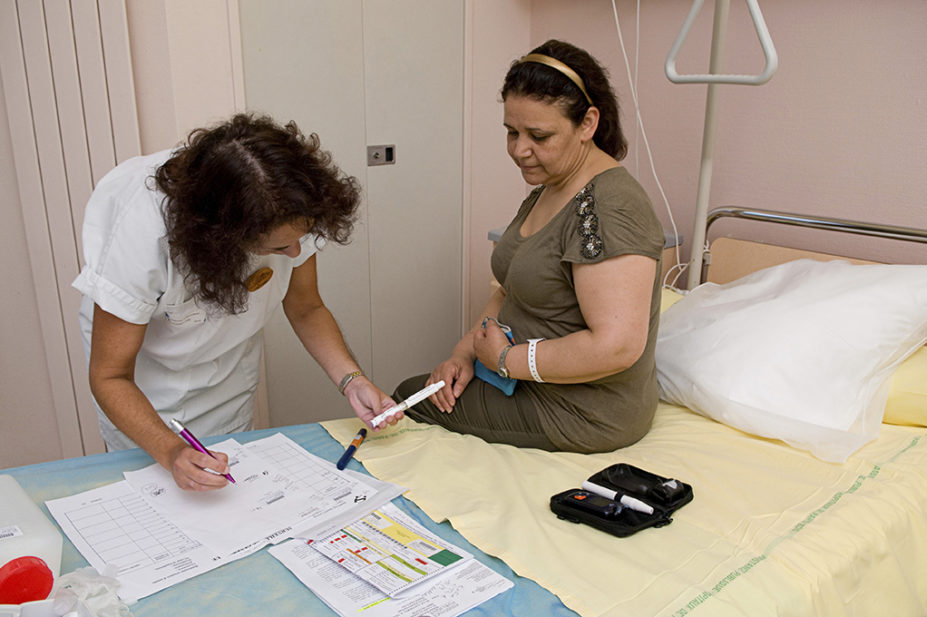
Science Photo Library
Treatment with subcutaneous insulin is essential for many people with type 1 and type 2 diabetes and is both a time-critical and high-risk drug.
Insulin errors are commonly reported and are frequently associated with significant patient harm[1–3]. Results from the latest National Diabetes Inpatient Audit, published in November 2020, show that two-fifths of people taking insulin experienced one or more insulin error during a stay in hospital — an unacceptably high figure that has not significantly reduced since 2017[4,5].
Often, reported insulin prescribing errors in hospital involve miscommunications or mistakes concerning the name of the insulin itself (e.g. Humalog instead of Humalog mix 50), the number of units prescribed, the insulin’s concentration and/or frequency, or device, such as pens or pumps. Other errors include inappropriately timed doses (e.g. mixed insulins prescribed for night-time administration), insulin not being prescribed when it should be, unsigned prescriptions delaying administration, or the confusing use of abbreviations (e.g. ‘u’ for units).
The complexity of the insulin prescribing process for individual patients further accentuates the potential for error and harm
Another problem is the variety of insulin products and types available, including concentrated and biosimilar insulins, often with obscure or similar sounding names. The complexity of the insulin prescribing process for individual patients — considering that each patient requires individualised dosing and regimen — further accentuates the potential for error and harm. There is also often a lack of knowledge regarding diabetes and insulin use among non-specialist prescribers and a culture of reluctance to contest unclear insulin prescribing[6–8].
In the same way as most medication errors, many insulin prescribing errors are avoidable, although there is little evidence to support suggested interventions, such as insulin passports, prescribing charts, improved guidelines and training, and electronic prescribing[9–11].
Insulin prescribing
To help plug this gap in evidence, we carried out research from 2018–2020 to investigate how current inpatient prescribing systems for insulin work in NHS hospitals and what — if any — interventions to reduce insulin errors are being used.
Following a systematic review of the literature, we designed a survey to capture quantitative information from hospital trusts regarding the use and functionality of electronic and paper prescribing systems, as well as the effectiveness and availability of interventions designed to reduce insulin prescribing errors[12–14].
We then carried out an in-depth qualitative investigation of salient issues using in-depth, semi-structured interviews with 19 healthcare professionals from a range of acute trusts, involving specialist diabetes pharmacists, medicines safety officers and clinical pharmacists.
Overall, the main findings suggested that national efforts to improve insulin errors may be hindered by the wide variation across NHS trusts in both prescribing system functionality and interventions to support insulin prescribing. This was combined with wider organisational factors, such as high staff turnover.
Several trusts reported using concomitant electronic and paper systems to prescribe insulin (e.g. cross-referencing a paper chart), which participants described as conferring increased risk. Where electronic systems are used for subcutaneous insulin, certain safety features are often absent (e.g. alerts for high doses, insulin order sets), meaning that potentially dangerous insulin errors can, and still do, occur.
Safety training
Although insulin safety training may be effective for improving insulin prescribing practice, this was thought to only really be effective if mandatory, and more than half of trusts surveyed did not offer mandatory insulin training to clinical staff. The insulin passport, previously recommended by the (now defunct) National Patient Safety Agency, was seldom used, and was regarded as one of the least effective interventions available for reducing insulin errors.
Issues with accessing complete and contemporaneous prescription information for individual patients at the point of admission to hospital was described as a particular risk to safe insulin prescribing for inpatients.
Our study supports recent recommendations for pharmacist involvement in specialist diabetes teams[15,16]. For example, the use of interventions to reduce insulin errors was positively associated with the availability of specialist diabetes pharmacists. Also, participants described how pharmacists worked across teams to design and implement improvements to insulin prescribing practice in their organisations.
Insulin prescribing safety interventions should be designed so that all staff are empowered to make safe decisions with respect to insulin prescribing
Recommendations
These results led us to conclude that although insulin prescribing safety is a complex issue, there are six recommendations that could help further improve insulin prescribing safety in the inpatient setting.
1. All trusts should have a dedicated insulin safety team that comprises a broad membership to facilitate sustainability and spread of interventions to improve insulin prescribing practice. Inclusion of primary care representation would further promote insulin safety efforts and continuity of safe care across care interfaces.
2. Prescribing systems (paper or electronic) should reduce the cognitive work required, for example by using electronic insulin order sets linked to trust formularies or pre-printed paper insulin prescribing charts. They should also be easily identifiable, for example using coloured paper charts and the inclusion of the word ‘insulin’ next to the product name on the electronic system. Insulin prescriptions should be proximal to readily accessible blood glucose results. Electronic systems need to be flexibly designed to enable insulin to be prescribed appropriately for individual patients, particularly as certain safety features (restrictive functions/limits) are not easily applicable to insulin.
3. Local guidance regarding insulin prescribing, particularly in special situations (e.g. peri-operative/dose titrations/hyperglycaemia etc.) should be up to date, brief, easy to follow and readily available for prescribers.
4. Current systems/technology that span care interfaces (e.g. the summary care record) should be used to include current insulin prescribing information (including doses). Inclusion of a well-staffed pharmacy team at the front door of the hospital would facilitate the timeliness and accuracy of insulin prescribing and administration at the point of admission.
5. The implementation of insulin prescribing safety interventions requires dedicated time and a ‘whole systems’ approach involving non-diabetes specialist teams to be effective. These should be designed so that all staff – especially those without specialist diabetes knowledge — are empowered to make safe decisions with respect to insulin prescribing. This may help relieve the burden of responsibility for insulin safety falling on to specialist diabetes teams, particularly where capacity is an issue.
6. Although mandatory insulin safety training for clinical staff is recommended, brief sessions or training packages completed at induction into a new role are unlikely to be effective. Active learning strategies using simulated and experiential training, and individual/group reflection on practise, are likely to be successful. Well-designed, mandatory, repeated e-learning packages that incorporate individual reflection and discussion are useful alternatives.
Amie Bain is a senior pharmacist for emergency and acute medicine at Wye Valley NHS Trust
- 1ISMP List of High-Alert Medications in Acute Care Settings. Institute of Safe Medication Practitices. 2011.https://www.ismp.org/Tools/institutionalhighAlert.asp (accessed Jul 2021).
- 2Lane N, Hunter I. Lessons learned: using adverse incident reports to investigate the characteristics and causes of prescribing errors. BMJ Open Qual 2020;9:e000949. doi:10.1136/bmjoq-2020-000949
- 3The top ten prescribing errors in practice and how to avoid them. Pharmaceutical Journal Published Online First: 2019. doi:10.1211/pj.2019.20206123
- 4National Diabetes Inpatient Audit England, 2019. NHS Digital. 2020.https://files.digital.nhs.uk/65/504167/NaDIA%202019%20-%20Full%20Report%20v1.0.pdf (accessed Jul 2021).
- 5National Diabetes Inpatient Audit England and Wales, 2017. NHS England and Wales. 2018.https://files.digital.nhs.uk/pdf/s/7/nadia-17-rep.pdf (accessed Jul 2021).
- 6Lee MKS, Liu Z, Quek TPL, et al. Insulin-Related Knowledge Among Health Care Professionals at a Tertiary Hospital. Diabetes Spectrum 2013;26:187–93. doi:10.2337/diaspect.26.3.187
- 7Bain A, Kavanagh S, McCarthy S, et al. Assessment of Insulin-related Knowledge among Healthcare Professionals in a Large Teaching Hospital in the United Kingdom. Pharmacy 2019;7:16. doi:10.3390/pharmacy7010016
- 8Medicines in health and adult social care: Learning from risks and sharing good practice for better outcomes. Care Quality Commission. 2019.https://www.cqc.org.uk/sites/default/files/20190605_medicines_in_health_and_adult_social_care_report.pdf (accessed Jul 2021).
- 9Patient Safety Alert NPSA/2011/PSA003: The adult patient ’s passport to safer use of insulin. National Patient Safety Agency. 2011.https://www.ukmi.nhs.uk/filestore/ukmiaps/NPSA-2011-PSA03(2).pdf (accessed Jul 2021).
- 10Dashora U, Sampson M, Castro E, et al. Rowan Hillson Insulin Safety Award ‘best in class’ insulin prescription chart competition. Br J Diabetes 2015;15:135. doi:10.15277/bjdvd.2015.028
- 11Watts E, Rayman G. Making hospitals safe for people with diabetes . Diabetes. 2019.https://www.diabetes.org.uk/resources-s3/2018-10/Making%20Hospitals%20safe%20for%20people%20with%20diabetes_FINAL.pdf (accessed Jul 2021).
- 12Bain A, Hasan SS, Babar Z-U-D. Interventions to improve insulin prescribing practice for people with diabetes in hospital: a systematic review. Diabet Med 2019;36:948–60. doi:10.1111/dme.13982
- 13Bain A, Hasan SS, Kavanagh S, et al. Strategies to reduce insulin prescribing errors in UK hospitals: results from a national survey. Diabet Med 2019;37:1176–84. doi:10.1111/dme.14209
- 14Bain A, Hasan SS, Kavanagh S, et al. Use and validation of a survey tool to measure the perceived effectiveness of insulin prescribing safety interventions in UK hospitals. Diabet Med 2020;37:2027–34. doi:10.1111/dme.14351
- 15Joint British Diabetes Societies for inpatient care: A good inpatient diabetes service. The Association of British Clinical Diabetologists. 2019.https://abcd.care/sites/abcd.care/files/site_uploads/A_good_Inpatient%20Service_FINAL_Aug_19.pdf (accessed Jul 2021).
- 16Rayman G, Kar P. Diabetes GIRFT Programme National Specialty Report. Getting It Right First Time (GIRFT). 2020.https://www.gettingitrightfirsttime.co.uk/wp-content/uploads/2020/11/GIRFT-diabetes-report.pdf (accessed Jul 2021).


